How to Build a Survival Kit on Bushcraft Principles.: "
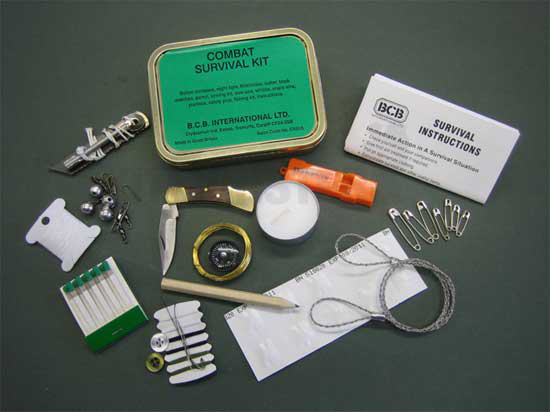
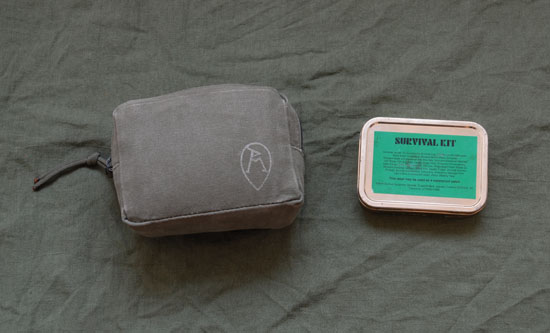
Article printed from Paul Kirtley's Blog: http://paulkirtley.co.uk
URL to article: http://paulkirtley.co.uk/2011/bushcraft-survival-kit/
URLs in this post:
 "
"
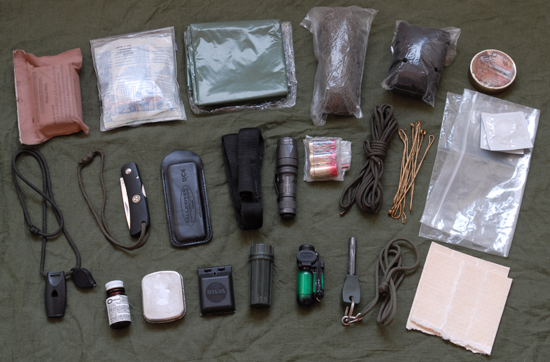
- A Bushcraft Survival Kit. Photo: Paul Kirtley
Having been given a copy of John ‘Lofty’ Wiseman’s ‘SAS Survival Handbook’ when I was 13 years old, I spent a disproportionate amount of my mid-teens devising ingenious ways to cram more and more survival kit into a tobacco tin. At the weekend I’d go to the local woods with my friends and we did what all good survivors did – build shelters, light fires and whittle sticks.
Whenever I wanted to use something from my survival tin, it was hard to avoid disturbing most of the contents. I’d squeezed so much good stuff in there, I’d created something of a Chinese puzzle. It was difficult to unpack and always impossible to re-pack to the standard I’d managed at home. I’d often resort to putting a few bits and pieces in my jacket pocket rather than back in the tin. I came to the conclusion that less was definitely more. Later, I also assembled the components Lofty suggested for a ‘survival pouch’.
I persevered with the tobacco tin survival kit and survival pouch for years, carrying them with me “just in case” while hiking and on many camping trips. While I used some of the items from the survival pouch on a daily basis, I found myself packing survival kit then packing many items that replicated the functions of items in the survival kit.
The replication of kit between survival kit and day-to-day kit continued to bug me. Then I went through a lightweight backpacking phase and really pared down everything I took with me. In the end, I left much of the survival kit at home and relied solely on the little ‘bubble’ of safety created by the modern camping equipment I carried with me. After a while I got bored with being in my bubble. I wanted a closer relationship with the environment I was visiting. It was then I sought out Ray Mears to learn what he was calling bushcraft.

Combat Survival Tin
I still love the concept of the tobacco-tin survival kit. There is so much function in such a small package. The ‘Combat Survival Tin’ makes perfect sense in the context of the soldier, who has much ammunition and other heavy equipment to carry. As outdoors people, though, we are allowed a different equation. We choose to enter wild places for the sake of being there. We can take with us equipment that allows us to live there for an extended period of time. My experience of wilderness travel and living outdoors for weeks or even months at a time, combined with a knowledge of bushcraft, has changed my perspective on my own personal ‘survival kit’.
My ‘bushcraft survival kit’ is designed to be functional in itself. It is a stand-alone entity. To this extent it pays homage to Lofty’s doctrine. It is also designed to dovetail with my other basic wilderness equipment with little overlap, except where valuable back-up to critical wilderness equipment [1] is provided. Most important, the components are assembled with day-to-day use in mind. So, rather than including a couple of scalpel blades, I include a good quality pocket knife; rather than including a small flint striker, I include a full-size Swedish Firesteel; and so on. If you are living in the outdoors, rather than merely visiting (in a bubble), then the equipment you have for living there is largely your survival equipment. With a few exceptions of kit intended purely for emergencies, this equipment will be used on a regular basis if not every day.

Bushcraft Survival Kit and Combat Survival Tin. Photo: Paul Kirtley.
The Bushcraft Survival Kit Expalined
Folding Knife
While a knife with a fixed blade is stronger, a folding knife is a useful tool as long as it has a locking blade. While it provides a back-up, a lock-knife should be of high enough quality to be used for many of the jobs you would undertake with your main bushcraft knife. I was introduced to the Fjallkniven TK4 knife by Lars Falt and have carried one ever since. It is manufactured from high-quality materials, well-made and remarkably light in weight. A knife of this size should not be underestimated. It is entirely possible to gut, skin and disassemble an animal as large as a deer with a small knife. The back of the TK4 can be used to create sparks with the Swedish Firesteel or ‘Fireflash’. With a folding knife, this action is far safer when the blade is closed. When the knife is open there is a danger it will close on your fingers if you accidentally release the locking mechanism. I write from personal experience…
While a knife with a fixed blade is stronger, a folding knife is a useful tool as long as it has a locking blade. While it provides a back-up, a lock-knife should be of high enough quality to be used for many of the jobs you would undertake with your main bushcraft knife. I was introduced to the Fjallkniven TK4 knife by Lars Falt and have carried one ever since. It is manufactured from high-quality materials, well-made and remarkably light in weight. A knife of this size should not be underestimated. It is entirely possible to gut, skin and disassemble an animal as large as a deer with a small knife. The back of the TK4 can be used to create sparks with the Swedish Firesteel or ‘Fireflash’. With a folding knife, this action is far safer when the blade is closed. When the knife is open there is a danger it will close on your fingers if you accidentally release the locking mechanism. I write from personal experience…

- A quality lock knife such as the Fjallkniven TK4 is a valuable tool. Photo: Paul Kirtley.
Fireflash
As described in my article ‘Essential Wilderness Equipment [1]‘, the Swedish Firesteel is the most dependable aid to fire-starting. They last a long time so you only need carry one with you for both day-to-day use and emergencies.
As described in my article ‘Essential Wilderness Equipment [1]‘, the Swedish Firesteel is the most dependable aid to fire-starting. They last a long time so you only need carry one with you for both day-to-day use and emergencies.
Sharpening Stone
Also described in my article ‘Essential Wilderness Equipment [1]‘, the Fjallkniven DC4 is a portable and efficient whetstone that is easy to use.
Also described in my article ‘Essential Wilderness Equipment [1]‘, the Fjallkniven DC4 is a portable and efficient whetstone that is easy to use.
Whistle
Blowing a whistle uses less energy than shouting for help and the sound carries further. Carry one at all times. A model that is made of tough material and has no moving parts is reliable. The Fox40 Micro meets these criteria and is very loud.
Blowing a whistle uses less energy than shouting for help and the sound carries further. Carry one at all times. A model that is made of tough material and has no moving parts is reliable. The Fox40 Micro meets these criteria and is very loud.
Microlight
A small LED light kept on your person is handy for when you need a little local illumination. It can make jobs that would otherwise be difficult in the dark easy; for example, changing the batteries of your main torch. I use a powerful LED torch as my main torch but it is overpowering for jobs that only need a low level of light. The Photon ‘Freedom’ Microlight has a dimmer control so you can bring the light level up gradually to the level you want – ideal for night-time map reading without losing too much of your night vision. LED microlights typically have a long battery life so I don’t carry a spare battery. If you wanted to carry a spare, it would be just as easy to carry a spare microlight. I carry a Photon ‘Freedom’ Microlight and a Fox40 Micro whistle on a cord around my neck.
A small LED light kept on your person is handy for when you need a little local illumination. It can make jobs that would otherwise be difficult in the dark easy; for example, changing the batteries of your main torch. I use a powerful LED torch as my main torch but it is overpowering for jobs that only need a low level of light. The Photon ‘Freedom’ Microlight has a dimmer control so you can bring the light level up gradually to the level you want – ideal for night-time map reading without losing too much of your night vision. LED microlights typically have a long battery life so I don’t carry a spare battery. If you wanted to carry a spare, it would be just as easy to carry a spare microlight. I carry a Photon ‘Freedom’ Microlight and a Fox40 Micro whistle on a cord around my neck.
Paracord
Invaluable for a multitude of tasks from bow-drilling to making improvised snow-shoes, you should always have a hank of paracord with you. Genuine 550-lb breaking strain paracord has a number of internal strands that can be stripped out and used for tasks such as sewing repairs or making a fishing line.
Invaluable for a multitude of tasks from bow-drilling to making improvised snow-shoes, you should always have a hank of paracord with you. Genuine 550-lb breaking strain paracord has a number of internal strands that can be stripped out and used for tasks such as sewing repairs or making a fishing line.
Matches
My first choice for day-to-day fire-lighting is the Swedish Firesteel because it lasts such a long time – 12,000 strikes according the manufacturer. Matches, by contrast, get used up relatively quickly (imagine carrying 12,000 matches!). For some firelighting situations though, matches make your life easier. For example, lighting match-stick thickness kindling (think small Spruce (Picea) or Hemlock (Tsuga) twigs), is much easier with matches when you have no tinder on which to drop a spark. I reserve most of my matches for an emergency. If I do use any matches, I replace them as soon as I can. Strike anywhere matches are preferable to safety matches. Keep them in a watertight container packed with a little cotton-wool to stop them rattling.
My first choice for day-to-day fire-lighting is the Swedish Firesteel because it lasts such a long time – 12,000 strikes according the manufacturer. Matches, by contrast, get used up relatively quickly (imagine carrying 12,000 matches!). For some firelighting situations though, matches make your life easier. For example, lighting match-stick thickness kindling (think small Spruce (Picea) or Hemlock (Tsuga) twigs), is much easier with matches when you have no tinder on which to drop a spark. I reserve most of my matches for an emergency. If I do use any matches, I replace them as soon as I can. Strike anywhere matches are preferable to safety matches. Keep them in a watertight container packed with a little cotton-wool to stop them rattling.
Cigarette Lighter
A lighter is useful for fire-lighting and, unlike matches, will work after a dunk in water. It’s also useful for day-to-day jobs such as melting the end of a length of paracord to prevent fraying. A good quality blow-torch lighter can be used for fixing equipment and finishing off creme-brulee!
A lighter is useful for fire-lighting and, unlike matches, will work after a dunk in water. It’s also useful for day-to-day jobs such as melting the end of a length of paracord to prevent fraying. A good quality blow-torch lighter can be used for fixing equipment and finishing off creme-brulee!
Tinder
Waxed paper of the sort that is like thick card is very dependable tinder for establishing a fire. This material can be lit directly with matches or a cigarette lighter. Alternatively it can be scraped up with your knife in a manner similar to birch bark and ignited with a spark from your fireflash. Due to being infused with wax it repels water. Again I keep this for emergencies.
Waxed paper of the sort that is like thick card is very dependable tinder for establishing a fire. This material can be lit directly with matches or a cigarette lighter. Alternatively it can be scraped up with your knife in a manner similar to birch bark and ignited with a spark from your fireflash. Due to being infused with wax it repels water. Again I keep this for emergencies.
Torch
A good quality torch is worth the expense, particularly if you camp outside of the summer months. I like a torch with a powerful beam that can be used for route-finding in the dark. This also makes it a very good emergency signaling device. A torch that is waterproof is ideal for wilderness use. I find the no-compromise Surefire ‘Outdoorsman’ flashlights very good. This model’s construction makes it extremely tough. It is waterproofed with rubber O-rings and runs on only one CR123A lithium battery. Lithium batteries are lighter than alkaline batteries and work better in low temperatures. I carry 3 spare batteries. I also carry a strap that converts the flashlight into a head torch. Overall it’s a tough, versatile and high-performance combination.
A good quality torch is worth the expense, particularly if you camp outside of the summer months. I like a torch with a powerful beam that can be used for route-finding in the dark. This also makes it a very good emergency signaling device. A torch that is waterproof is ideal for wilderness use. I find the no-compromise Surefire ‘Outdoorsman’ flashlights very good. This model’s construction makes it extremely tough. It is waterproofed with rubber O-rings and runs on only one CR123A lithium battery. Lithium batteries are lighter than alkaline batteries and work better in low temperatures. I carry 3 spare batteries. I also carry a strap that converts the flashlight into a head torch. Overall it’s a tough, versatile and high-performance combination.
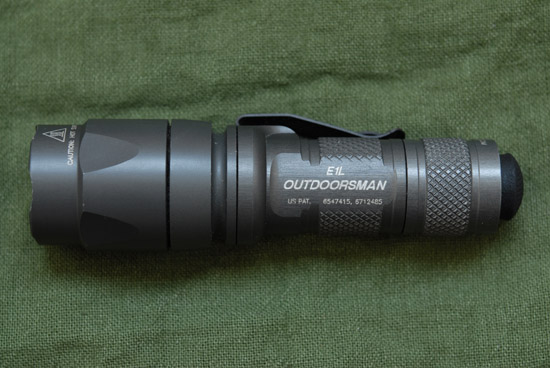
- The Surefire E1L Outdoorsman: A sturdy torch with no-compromise build quality. Photo: Paul Kirtley.
Water Purification Tablets
Iodine or chlorine water purification tablets are compact and easy to carry. Carrying a chemical treatment for water gives you an alternative to boiling. Iodine tablets are my first choice. Iodine deals with the tougher pathogenic organisms such as giardia and cryptosporidium, whereas chlorine doesn’t. Unfortunately due to the European Biocides Directive 98/8/EC, iodine has been unavailable for sale within the EU as a treatment for drinking water since October 2009. Iodine is still available outside of the EU. Please note that Iodine must not be consumed by those with thyroid problems or by women who are pregnant.
Iodine or chlorine water purification tablets are compact and easy to carry. Carrying a chemical treatment for water gives you an alternative to boiling. Iodine tablets are my first choice. Iodine deals with the tougher pathogenic organisms such as giardia and cryptosporidium, whereas chlorine doesn’t. Unfortunately due to the European Biocides Directive 98/8/EC, iodine has been unavailable for sale within the EU as a treatment for drinking water since October 2009. Iodine is still available outside of the EU. Please note that Iodine must not be consumed by those with thyroid problems or by women who are pregnant.
Resealable Plastic Bags
Resealable bags have many uses. As long as the bag is not punctured it can be used for storing water when you are without a water bottle. If you are without a metal mug or pot in which to boil water, you can use your chemical water treatment in the plastic bag too. A plastic bag is also useful for collecting and storing foraged foods such as berries.
Resealable bags have many uses. As long as the bag is not punctured it can be used for storing water when you are without a water bottle. If you are without a metal mug or pot in which to boil water, you can use your chemical water treatment in the plastic bag too. A plastic bag is also useful for collecting and storing foraged foods such as berries.
Unlubricated Condoms
These are purely emergency items! They can be used to store water and can be protected with a spare sock or similar. Make sure they are unlubricated.
These are purely emergency items! They can be used to store water and can be protected with a spare sock or similar. Make sure they are unlubricated.
Snares
Snares are indiscriminate and used incorrectly can cause great suffering to an animal. They should not be toyed with. In experienced hands snares are very effective and, in a survival situation, they can provide you with valuable fat and protein. This is nutrition that can be impossible to obtain from foraging for plant foods and fungi, particularly during winter and spring. Moreover, snares work for you while you do other things. Some brass snare wire, or snares already made up for the most likely small game, are a sensible and realistic addition to a survival kit. Snaring is illegal in many jurisdictions and requires a licence in others.
Snares are indiscriminate and used incorrectly can cause great suffering to an animal. They should not be toyed with. In experienced hands snares are very effective and, in a survival situation, they can provide you with valuable fat and protein. This is nutrition that can be impossible to obtain from foraging for plant foods and fungi, particularly during winter and spring. Moreover, snares work for you while you do other things. Some brass snare wire, or snares already made up for the most likely small game, are a sensible and realistic addition to a survival kit. Snaring is illegal in many jurisdictions and requires a licence in others.
Fishing Kit
Survival fishing is about catching fish. Your fishing kit should help provide dinner rather than just a pleasant day by the river. Pack kit that you know how to use and that has a wide application. The best return on your time and energy is provided by passive methods of fishing such as night line fishing. In my kit I have monofilament, stainless steel wire for making leaders and an assortment of hooks, jigs, jellies, and split shot. I put all this in a small tin to keep the hooks safe and prevent any of the small items from becoming lost. Remember you can use the inner cord of your paracord in combination with your fishing kit. Fishing without a rod and the use of a night line are illegal in some jurisdictions. Check before you decide to practice your skills!
Survival fishing is about catching fish. Your fishing kit should help provide dinner rather than just a pleasant day by the river. Pack kit that you know how to use and that has a wide application. The best return on your time and energy is provided by passive methods of fishing such as night line fishing. In my kit I have monofilament, stainless steel wire for making leaders and an assortment of hooks, jigs, jellies, and split shot. I put all this in a small tin to keep the hooks safe and prevent any of the small items from becoming lost. Remember you can use the inner cord of your paracord in combination with your fishing kit. Fishing without a rod and the use of a night line are illegal in some jurisdictions. Check before you decide to practice your skills!
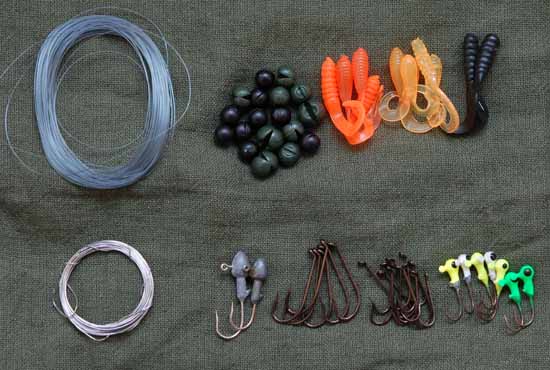
- Survival Fishing Kit. Photo: Paul Kirtley.
Sewing Kit
A few needles, some strong thread and some safety pins. I keep these items in the fishing kit.
A few needles, some strong thread and some safety pins. I keep these items in the fishing kit.
Compass
While I always have a compass in my shirt or jacket pocket, I like to carry a back-up compass. The favourite of survival kits is the button compass. Navigating with any precision with a button compass is difficult. A miniature base-plate or sighting compass is ideal. The Silva ‘Ranger 27′ is a small sighting compass that is fantastic as a back-up. It functions like big brothers ‘Ranger 16′ and ‘Expedition 15′ and is capable of precise navigation. Like its larger brethren, the ‘Ranger 27′ has a sighting mirror. By reflecting sunlight, a mirror can be used for emergency signaling over large distances.
While I always have a compass in my shirt or jacket pocket, I like to carry a back-up compass. The favourite of survival kits is the button compass. Navigating with any precision with a button compass is difficult. A miniature base-plate or sighting compass is ideal. The Silva ‘Ranger 27′ is a small sighting compass that is fantastic as a back-up. It functions like big brothers ‘Ranger 16′ and ‘Expedition 15′ and is capable of precise navigation. Like its larger brethren, the ‘Ranger 27′ has a sighting mirror. By reflecting sunlight, a mirror can be used for emergency signaling over large distances.
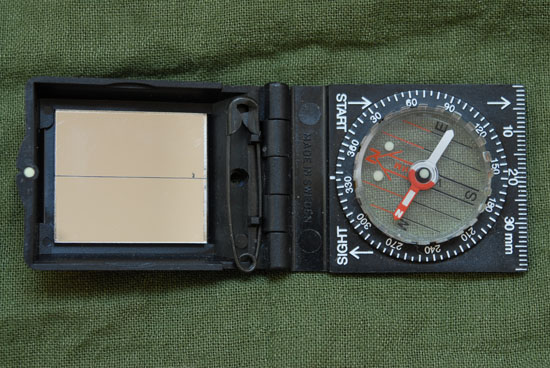
- Silva Ranger 27 Compass: A miniature but fully-functional back-up compass. Photo: Paul Kirtley.
Optional Extras
Survival bag
A survival bag is a large plastic bag, big enough for at least one person to get into, for use as an emergency shelter or part of a hypothermia [2] wrap. You can cut open two of the three sides and make the bag into a single sheet. This can then be used as a tarp or a lean-to. A large polythene sheet is also an effective way of collecting rain water. Survival bags are typically bright orange so they are visible from afar and easily seen by searchers/rescuers.
Survival bag
A survival bag is a large plastic bag, big enough for at least one person to get into, for use as an emergency shelter or part of a hypothermia [2] wrap. You can cut open two of the three sides and make the bag into a single sheet. This can then be used as a tarp or a lean-to. A large polythene sheet is also an effective way of collecting rain water. Survival bags are typically bright orange so they are visible from afar and easily seen by searchers/rescuers.
Gill Net
A gill net is a very unsporting yet extremely effective way of removing fish from water. Fish swim into the net and become stuck and then entangled as they struggle. It is a passive method of fishing, allowing you time and energy to attend to other priorities. The use of a gill net is illegal in many jurisdictions, including the UK.
A gill net is a very unsporting yet extremely effective way of removing fish from water. Fish swim into the net and become stuck and then entangled as they struggle. It is a passive method of fishing, allowing you time and energy to attend to other priorities. The use of a gill net is illegal in many jurisdictions, including the UK.
Mosquito Head-Net
In mosquito-infested regions, a head-net is essential if you are not to be driven to distraction. A head-net has several other uses including fishing and melting snow for drinking water. Many head-nets are impregnated with insect repellent, which can be harmful if consumed (by humans as well as insects). For generating drinking water from snow you should use a net that is untreated.
In mosquito-infested regions, a head-net is essential if you are not to be driven to distraction. A head-net has several other uses including fishing and melting snow for drinking water. Many head-nets are impregnated with insect repellent, which can be harmful if consumed (by humans as well as insects). For generating drinking water from snow you should use a net that is untreated.
Insect Repellant
From a survival standpoint insect repellant may seem like a luxury at first glance. Biting insects can make life a misery though. They can cause so much distraction that you don’t pay attention to dangers or that you injure yourself, particularly if you’re using cutting tools.
From a survival standpoint insect repellant may seem like a luxury at first glance. Biting insects can make life a misery though. They can cause so much distraction that you don’t pay attention to dangers or that you injure yourself, particularly if you’re using cutting tools.
Medical Kit
Cuts Kit
As described in ’Essential Wilderness Equipment [1]‘ a small first aid kit capable of dealing with cuts and other minor injuries is prudent.
Cuts Kit
As described in ’Essential Wilderness Equipment [1]‘ a small first aid kit capable of dealing with cuts and other minor injuries is prudent.
Dressing
Adding a substantial dressing allows you do deal with more serious injuries. Military dressings are highly absorbent and come in a waterproof wrapper.
Adding a substantial dressing allows you do deal with more serious injuries. Military dressings are highly absorbent and come in a waterproof wrapper.
Surivival Priorities
Assuming you are not injured, your basic needs are shelter, fire, water and food, not necessarily in that order. The order will change depending on where in the world you are and what condition you are in.
Assuming you are not injured, your basic needs are shelter, fire, water and food, not necessarily in that order. The order will change depending on where in the world you are and what condition you are in.
Your survival priorities can be addressed by remembering the acronym PLAN-M [3]. PLAN-M [3] stands for protection, location, acquisition, navigation and medical. The bushcraft survival kit described above addresses each of these needs in a substantial way, with many of the items of equipment having multiple uses, across categories. Knowledge and skill, however, are more important than equipment and equipment will only be of use to you to the extent you have the bushcraft knowledge and survival skills to use it. Treat every piece of equipment you have as a bonus.
A Modular Approach
The equipment comprising my bushcraft survival kit fits into a small canvas pouch. The fireflash, sharpening stone and cuts kit are the same pieces of equipment as discussed in my article ‘Essential Wilderness Equipment [1]‘. These and some of the other contents of my bushcraft survival kit are kept on my person when out in wild country. At other times they are kept in the pouch. The only places the items are allowed to be are either on my person or in the pouch. It’s then very easy to grab the pouch – either when packing for a trip or in an emergency – and know you have everything.
The equipment comprising my bushcraft survival kit fits into a small canvas pouch. The fireflash, sharpening stone and cuts kit are the same pieces of equipment as discussed in my article ‘Essential Wilderness Equipment [1]‘. These and some of the other contents of my bushcraft survival kit are kept on my person when out in wild country. At other times they are kept in the pouch. The only places the items are allowed to be are either on my person or in the pouch. It’s then very easy to grab the pouch – either when packing for a trip or in an emergency – and know you have everything.
My bushcraft survival kit functions as a survival kit in its own right. But it also dovetails with other wilderness bushcraft equipment. The bushcraft survival kit pouch and water bottle pouch can be added to a daypack along with some food, a warm layer, hat, waterproofs, maps and compass and you have everything you need for many day-hikes. In wild and remote country, you should certainly add some more serious cutting tools such as a bushcraft knife and folding saw. You would probably also want to add a more substantial wilderness first aid kit. These are the basic building blocks of my bushcraft and survival equipment. Taking a modular approach really helps to make sure you have everything you might need as well as cut out excess “just in case equipment”.
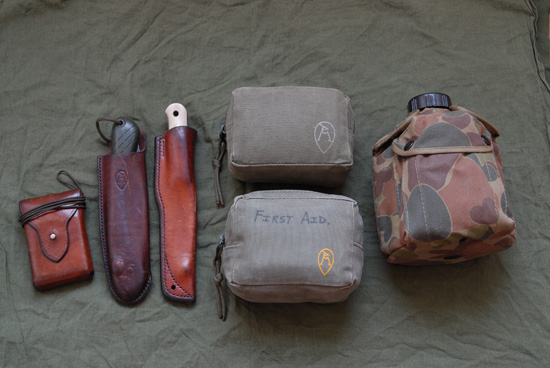
- The building blocks of my bushcraft and survival equipment. From left to right: Compass; folding saw; bushcraft knife; bushcraft survival kit (top pouch); wilderness first aid kit (bottom pouch); waterbottle and metal mug in pouch.
If you agree, disagree, have questions, or have other equipment you would add to a ‘bushcraft survival kit’, let me and other readers know in the comments section.
Related Articles
Article printed from Paul Kirtley's Blog: http://paulkirtley.co.uk
URL to article: http://paulkirtley.co.uk/2011/bushcraft-survival-kit/
URLs in this post:
[1] wilderness equipment: http://paulkirtley.co.uk/2010/essential-wilderness-equipment/
[2] hypothermia: http://paulkirtley.co.uk/2010/hypothermia/
[3] PLAN-M: http://paulkirtley.co.uk/2010/plan-survival/
Comentários
Postar um comentário